4-Channel Conditioner (NL530)
Designed to provide gain and offset setup controls when interfacing signals to analog-to-digital converters (A/D’s) of PCs.
- Each module contains four channels
- Independently adjustable filter settings
- Independently adjustable front panel Gain presets
- Independently adjustable front panel Offset presets

The NL844 pre-amplifier is specifically designed to operate in conjunction with the NL820A Isolator. Its low noise and high impedance differential inputs make it particularly suitable for use as a headstage pre-amplifier close to the preparation, ideal for isolated EMG, EEG or ECG applications.
- Very low noise
- Up to four channels can be used
- Fast recovery time from stimulus artifact pulses
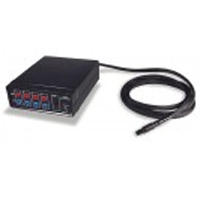
The NL-104A AC Preamplifier is a low noise, high input impedance, differential, preamplifier. It can be used alone for making recordings from low resistance (gross) electrodes, or with the NL100AK headstage for microelectrode recordings.
- A low noise, high input impedance, differential pre-amplifier
- Can be used alone for making recordings from low resistance electrodes
- Or used with the NL100AK headstage for microelectrode recordings
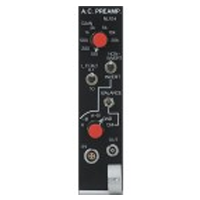
Features continuously adjustable attenuation or amplification using a locking ten-turn potentiometer (0 to x10) or (0 to x100).
- Attenuation or amplification
- Continuously adjustable
- Locking ten-turn potentiometer
- 0 to x10
- 0 to x100

This analog device contains a single pole change-over switch, the state of which is controlled by a logic signal.
- Signal can be generated either externally or by the internal Flip-Flop that can be toggled by a logic input
- Front panel switch allows direct selection of the switch state
- Switch state is indicated by an LED
- Switch is bi-directional

A power amplifier for driving a 4 or 8 ohm loudspeaker.
- Has sufficient power amplification to raise a ±20 mV signal to moderate sound level
- Input selector for switching between two input signals
- Options for amplifying only positive or negative peaks

The interface between any bipolar signal and two of the NeuroLog NL800 isolators.
- Enables stimulation using bipolar, isolated, constant current signals
- High input impedance
- Four input ranges
- Gated input
- Allows multiple units to be connected to a single analogue source

The NL50 Blank Module consists of an undrilled, finished front panel and an unassembled printed circuit board.
- Used to construct modules of your own design
- Compatible with the NL900 Case and power supply

Used for the precise calibration of the gain of an amplifier system.
- Enables precise calibration of amplifier gain by adding a pulse of accurate amplitude and duration to a recording trace
- Output of the calibrator is isolated
- Switches allow selection of 1 of 3 calibrated output levels
- 1 of 2 calibrated triggered pulse widths of either polarity

A 2-digit preset decade counter with a 2-digit light emitting diode decimal readout.
- Counters can be externally reset and gated
- Counters can be operated in one of three modes
- Preset-Reset
- Preset-Stop
- FREE RUN
- Up to 3 counters can be cascaded

A direct-coupled pre-amplifier designed specifically for intracellular recording.
- Electrode impedance checking
- Four current injection ranges of ±100, ±50, ±20, and ±10 nA
- Four bridge balance ranges of 100 MΩ, 200 MΩ, 500 MΩ, and 1000 MΩ
- DC level control
- Constant current capacitance compensation (neg. cap.)
- x1 output amplifier has ±10 V dynamic input signal range
- Low leakage current and low DC drift

The NL108T2 Pressure Transducer is a low cost alternative to the isolated unit NL108T1 which can be used with the NL108A Pressure Amplifier.
- Low cost alternative to isolated NL108TA
- Can be reused several times
- Available individually or in a package of 10

NL-101 Electrode Chambers are compatible with all Neurolog system headstages.
- Compatible with all Neurolog system headstages
- Available with two plug sizes
- Each plug size is available in four inside diameters to fit various glass capillary OD

This integrator module was designed to produce an analog signal to represent muscle activity.
- Will accept signals up to ±1 V
- Full-wave rectifies inputed signals
- Output of the integrator is buffered
- Overall gain is set at unity
- The time constant of the integrator is set by a 6-position rotary switch

These filter modules employ two active filter sections to control high and low pass characteristics.
- Low frequency cutoff set continuously from 0.5 Hz to 5 kHz
- Using single-turn potentiometer in four switched ranges
- High frequency cutoff set continuously from 5 Hz to 50 kHz
- Using single-turn potentiometer in four switched ranges

Flip-flop can be operated either as a set-reset flip-flop or as a toggled complementing flip-flop.
- Useful in setting up conditional and single-shot stimuli
- Useful for testing logic outputs for the presence of pulses, logic levels etc.
- It has three inputs and two outputs all of which drive or are driven from TTL logic (ie +5V and 0V)
- Inputs: Set, Complement and Clear
- Outputs Q and Q’
- LED indicator illuminated when Q output is at high level

A differential input, low noise, high impedance buffer amplifier.
- Contained in a metal tube
- Supplied with a 2 meter long flexible cable

A differential input, low noise, high impedance buffer amplifier.
- Contained in a metal tube
- Supplied with a 2 meter long flexible cable

The NeuroLog System is now widely accepted throughout the world by scientists who demand high quality, dependability and innovation in their research instrumentation.
- Intracellular Recording
- Extracellular Recording
- Spike Detection
- Electrical Stimulation
- Pulse & Train Generation
- Multi-channel EMG or EEG Recording
- Pressure or other Transducer Recordings

Provides four channels of high level signal isolation and a ±13 volt (nominal) isolated supply to power separate preamplifier stages.
- Four channels of high level signal isolation
- ±13 volt (nominal) isolated power supply
- To power separate preamplifier stages (eg NL822 or NL824)

This logic gate module contains two logic gates each with two inputs and complementary outputs.
- Contains two logic gates
- Each gate with two inputs and complementary outputs
- Both gates can be independently configured by PCB mounted switches
- 2-input AND gates
- 2-input OR gates.
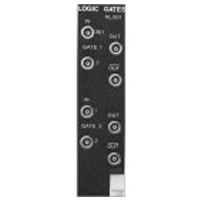
Various low and high pass filters.
- Four-channel two-pole filters
- With and without notch
- 50 and 60 Hz notch available
- Low and high pass filter options


This period generator contains a crystal oscillator and frequency dividers for producing a precise, stable frequency standard.
- The NL304 Period Generator contains:
- A crystal oscillator
- Frequency dividers

These Pre-Amplifiers are specifically designed to operate in conjunction with the NL820A Isolator.
- Pre-Amplifiers are specifically designed to operate in conjunction with the NL820A Isolator
- Small size and low noise
- High impedance differential inputs
- Suitable as head stage amplifiers
- Operate close to the preparation.
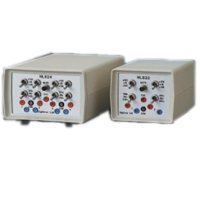
The NL100RK consists of an NL100AKS head-stage and the NL100C Stimulus Control module designed for use with the NL104A AC Preamplifier and allowing stimulation and recording through the same electrode.
- Allows stimulation and recording through the same electrode
- Stimulus can be controlled manually or from external device

This pressure amplifier module is designed both for blood pressure measurements and for low pressure measurements such as intratracheal pressure.
- Provides two gain settings
- One gain setting appropriate for blood pressure measurements
- One gain setting for low pressure measurements
- Intratracheal pressure

Suitable for both arterial and venous blood pressure monitoring allowing continuous pressure monitoring.
- The NL108T4 is attached via a lead (NL108L4) to the NL108A pressure amplifier
- Enables continuous pressure monitoring
- Highly rugged and reusable transducer

This pulse buffer converts TTL logic pulses into 0 to 10V pulses, or into input pulses.
- The NL510 Pulse Buffer converts TTL logic pulses into
- 0 to 10V pulses
- Input pulses
- Designed for the NL800 Stimulus Isolator

A low cost module for producing trains of uniform TTL pulses
- The NL301 Pulse Generator is a low cost module for producing trains of uniform TTL pulses
- It can be operated continuously, switched off, or a single pulse can be triggered manually
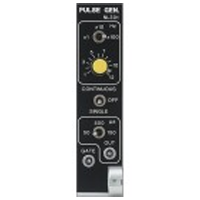
- Small handheld general purpose pulse generator
- Can be used to
- Start experiments
- Command the gate of a train of pulses
- Used with an NL102G to Buzz electrodes
- Self-powered by a standard internal 9 V battery

This pulse integrator has a digital counter which produces an analog output proportional to the count
- Has a digital counter which produces an analog output proportional to the count
- A pulse at the input socket increments the counter towards a full scale count of 255, 2550 or 25500
- These are pre-selectable by the front panel scale switch


This NeurologTM module frame and power supply are housed in a fully finished enclosed case.
- The case has handles and integral rack mounting hardware
- It can be shifted directly between rack and bench top
- The case contains 13 module bays plus power supply panel

This transducer amplifier is a DC coupled differential amplifier intended for use as a bridge amplifier or as recorder-matching amplifier.Wide gain range, an integral power supply for bridge excitation, excellent DC stability, switchable input time constants and a wide DC input offset adjustment are some of the NL107 features. A front panel switch grounds the output for recorder baseline adjustments. The input socket mates with the Lemo 4-Pole plug (NL963, not supplied).The NL201 Spike Trigger produces separate output pulse trains for spikes which:
- Cross the Upper voltage threshold
- Cross the Lower voltage threshold
- Cross the Lower but not the Upper threshold

A battery powered, light-coupled isolated stimulator.
- Constant current output
- Very high output impedance
- Low input-output capacitive coupling
- Accuracy/Linearity ± 3% of full scale output
- Suitable for stimulation through microelectrodes and gross electrodes

The NL143 Difference Amplifier allows the difference between two signals to be continuously monitored during the course of an experiment.
- Simultaneously monitors different signals
- Up to three differences can be recorded


